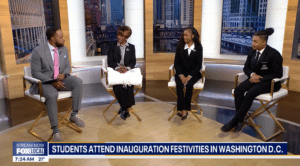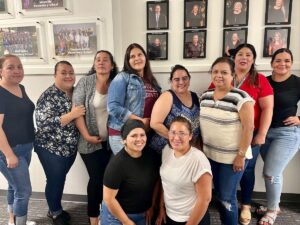Over the past four years, policy put forth by President Joe Biden’s administration represented a notable shift in the executive branch’s attitude toward multi-conglomerate merging. This merging refers to large corporations buying up smaller businesses from a variety of different industries, thus reducing the possibility of competition from small business.
During the Biden administration, the Federal Trade Commission (FTC) adopted an agenda of general deterrence on corporations that own too large a percentage of a given industry, often referred to as a monopoly, filing multiple high-profile antitrust lawsuits that drew national attention to then-FTC Chair Lina Khan. Khan’s lawsuits contradicted the deregulation agenda that began with President Ronald Reagan’s administration and was maintained by every president until Biden. President Biden justified the shift, stating, “We’re now 40 years into the experiment of letting giant corporations accumulate more and more power. And what have we gotten from it? Less growth, weakened investment, fewer small businesses. Too many Americans who feel left behind. Too many people who are poorer than their parents.”1
Khan was vocal about her belief that a major cause of inflation is corporate consolidation, or the merging of smaller businesses into monopolies. She noted that “even as some of the supply chain issues have eased, prices have not come down concurrently as much,” and implied that the manufactured inflation by large corporations was good for their profits.2 While there is no exact boundary within a given market that labels a corporation a monopoly, Khan stated that the FTC could look at the behavior of a corporation and see if it is operating with a “too big to care” approach, signaling they have too much power. This is where the Biden administration’s FTC would take antitrust action, using laws and regulations designed to prevent companies from forming monopolies or engaging in practices that unfairly restrict competition in the marketplace.3 The most recent attempt by the FTC to address such behavior was the proposed Kroger-Albertsons grocery merger, blocked in two different courts as of December 2024. The potential remains for the merger to move forward in President Donald Trump’s administration, which would result in the largest single grocery corporation in U.S. history.4
Khan pointed to the pharmaceutical industry, tech companies, and the hospitality industry as illustrative examples of how unchecked monopolies can drive up costs for Americans. For instance, the FTC claimed that the pharmaceutical company Teva filed improper patents on prescriptions like inhalers to prevent generic options from being made. It found that the same inhaler that costs $7 in France costs American consumers $500, as Americans are forced to buy the brand name.5 The FTC announced a bipartisan rule in December 2024 banning junk fees for concert tickets and hotel stays, stating, “People deserve to know up front what they are being asked to pay.”6 The FTC also announced that it would look into large artificial intelligence companies that it claimed are given undue influence on markets and are engaging in collusion or price-fixing at casinos and hotels by providing the same algorithms to entire industries that use them to set their prices.7
President Biden largely stood by the decisions of the FTC, though he declined to renominate Khan to another seven-year term as commissioner. Khan, who stepped down in 2025, garnered mixed reactions from both Republicans and Democrats. Notably, Vice President JD Vance has shown some support, stating that he doesn’t “agree with Lina Khan about everything, but (he) think(s) she’s been smart about going after these big tech companies.”8
The courts, however, do not always agree. The FTC lost high-profile cases, including antitrust suits it filed against tech companies Meta in 2020 and Microsoft in 2022. Startup founders have complained that that these lawsuits are scaring off investors so much that it’s stifling innovation. Some say the Biden administration’s FTC exercised too much power and are preparing to take action in district courts and, political experts suspect, in the Supreme Court.9
President Trump, meanwhile, designated Andrew Ferguson as the new chair of the FTC on his first day in office.
Discussion Questions
- Should the Trump administration’s FTC continue the trend of antitrust policies? What might be some benefits and drawbacks of this approach?
- Should there be a legally defined percentage of a given market that one corporation is allowed to have influence or ownership over? How might that affect American consumers?
- How do issues like prescription costs, junk fees, or AI impact your community? Do you think the actions taken by Khan and the FTC will change how they impact you? If so, how?
- How much control should the federal government have in limiting the power of monopolies? How might more control protect or harm consumers?
As always, we encourage you to join the discussion with your comments or questions below.
Close Up is proud to be the nation’s leading nonprofit civic education organization, working with schools and districts across the country since 1971. If you would like to partner with us or learn more about our experiential learning programs, professional development, or curriculum design and consulting, contact us today!
Sources
Featured Image Credit: Tom Williams/CQ-Roll Call via Getty Images
[1] The White House: https://www.whitehouse.gov/briefing-room/speeches-remarks/2021/07/09/remarks-by-president-biden-at-signing-of-an-executive-order-promoting-competition-in-the-american-economy/
[2] “60 Minutes”: https://www.youtube.com/watch?v=ebQtWZH3TW4
[3] Department of Justice: https://www.justice.gov/atr/antitrust-laws-and-you
[4] National Public Radio: https://www.npr.org/2024/12/10/nx-s1-5114999/kroger-albertsons-merger-ftc-lawsuit-court-ruling
[5] Federal Trade Commission: https://www.ftc.gov/news-events/news/press-releases/2024/03/ftc-files-amicus-brief-asthma-inhaler-patent-dispute
[6] Federal Trade Commission: https://www.ftc.gov/news-events/news/press-releases/2024/12/federal-trade-commission-announces-bipartisan-rule-banning-junk-ticket-hotel-fees
[7] Bloomberg Law: https://news.bloomberglaw.com/us-law-week/antitrust-risks-to-firms-lurk-inside-some-ai-pricing-algorithms
[8] CNBC: https://www.youtube.com/watch?v=w7MA2EkpRXM
[9] “60 Minutes”: https://www.youtube.com/watch?v=ebQtWZH3TW4

 HOOD RIVER — Twenty-five Hood River Valley High School (HRV) students in the migrant education program will head to Washington, D.C., over spring break to take part in the Close Up Foundation’s High School Program, “a six day and five night program for high school students to experience their government in action”.
HOOD RIVER — Twenty-five Hood River Valley High School (HRV) students in the migrant education program will head to Washington, D.C., over spring break to take part in the Close Up Foundation’s High School Program, “a six day and five night program for high school students to experience their government in action”. Welcome to The Hill’s Changemakers: 24 of 2024. For the second year in a row, we’re highlighting both the household names and lesser-known players who are making an impact at the Capitol and around the world. Whether you agree or disagree with them, these two dozen pathfinders are setting the pace and shaking things up in Washington.
Welcome to The Hill’s Changemakers: 24 of 2024. For the second year in a row, we’re highlighting both the household names and lesser-known players who are making an impact at the Capitol and around the world. Whether you agree or disagree with them, these two dozen pathfinders are setting the pace and shaking things up in Washington. Approximately 150 newly arrived immigrants and English Language Learners, who are Broward County Public Schools (BCPS) high school students, will take part in Rally to the Tally for New Floridians from December 10 – 13, 2024. This four-day field trip provides students the opportunity to see first-hand the legislative system at work. Students will visit the state capital and tour Florida Agricultural and Mechanical University, the University of Florida and the University of Central Florida.
Approximately 150 newly arrived immigrants and English Language Learners, who are Broward County Public Schools (BCPS) high school students, will take part in Rally to the Tally for New Floridians from December 10 – 13, 2024. This four-day field trip provides students the opportunity to see first-hand the legislative system at work. Students will visit the state capital and tour Florida Agricultural and Mechanical University, the University of Florida and the University of Central Florida.
 Washington
Washington
 The Importance of Our Right to Vote
The Importance of Our Right to Vote What is the United South and Eastern Tribes Inc. (USET)?
What is the United South and Eastern Tribes Inc. (USET)? Conclusion
Conclusion






